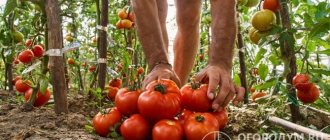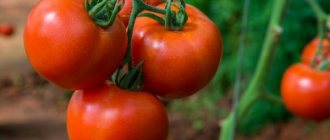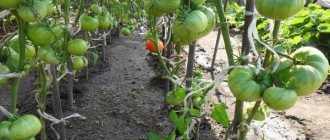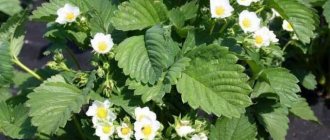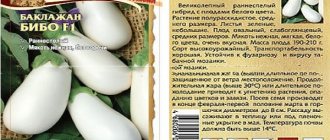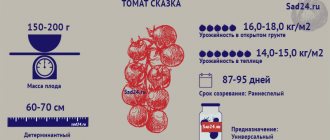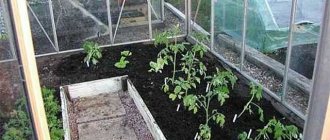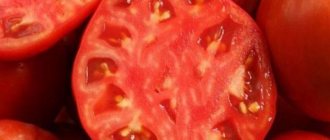Tomato Hali Gali F1 is a worthy decoration for the garden bed and table. This valuable variety enriches the diet with ripe, juicy tomatoes. Obtained through the efforts of Russian breeders from Siberia, registered in 2003.
| Height | Landing location | Ripening time | Fruit color | Fruit size | Origin | Fruit shape |
| Medium height | Greenhouse, Open ground | Early ripening | Reds | Average | Hybrid | Flat-round |
Tomato "Hali-Gali": description of the variety
| Variety name | Hali Gali |
| general description | Early ripening, determinate, standard variety of tomatoes |
| Originator | Russia |
| Ripening period | 85-105 days |
| Form | Round, with a characteristic spout |
| Color | Red |
| Average weight of tomatoes | 70-120 grams |
| Application | Universal |
| Productivity of the variety | 3 kg per bush |
| Features of cultivation | Requires shaping and tying |
| Disease resistance | Resistant to major diseases |
This is an early ripening hybrid; 85-105 days pass from the moment the seedlings are planted until the first mature fruits appear. Has F1 hybrids of the same name .
The bush is determinate, standard. Read about indeterminate varieties here. Like many modern hybrids, it resists fungal diseases and harmful insects well.
The “Hali-Gali” tomato variety is recommended for planting in open ground, but many are grown in greenhouses and greenhouses, on the balcony, due to the plant’s height of 50-90 cm.
Growing
Caring for determinate varieties consists of the following manipulations:
- Hilling is performed several times. The first time it should be done two weeks after planting the seedlings. The next hilling is carried out after another 14 days and so on 2 more times.
- The soil should be loosened regularly, since throughout the entire growing period the soil around the root system should remain airy.
- Watering is carried out as needed.
- Pinching allows you to form a bush with 1 or several shoots. Throughout the entire period of development of the bush, axillary inflorescences should be removed, as they take away the strength of the bush, as a result of which the yield of tomatoes decreases. For the same purpose, the lower leaves are also removed.
- Fertilizers are applied 2 weeks after planting in open ground or in a greenhouse. The next fertilization is carried out after the appearance of the second inflorescences.
Advice! To improve flower pollination, some gardeners gently shake the bushes from time to time. This is done during the day from 12 to 15 hours. Tomatoes with pistils are lightly watered so that pollen adheres to them more easily.
Advantages and disadvantages
Among the main positive qualities of this hybrid are::
- resistance to temperature changes;
- the ability to grow on a balcony in urban conditions;
- tolerance to lack of moisture;
- early ripeness;
- high sugar content.
Among the disadvantages are its not very high yield and its demanding fertilizing requirements.
Characteristics
The fruits of this species have one distinctive feature in appearance: a peculiar spout at the end. By this external feature they can be distinguished from other varieties. It is also worth noting its early ripening and resistance to temperature changes.
If you grow “Hali-Gali” tomatoes in open ground, then you can harvest up to 3 kg of tomatoes from each bush, with a recommended planting density of 3-4 bushes per square meter. m, thus comes out to 12 kg.
You can compare this indicator with other varieties below:
| Variety name | Productivity |
| Hali Gali | 3 kg per bush |
| Pink spam | 20-25 kg per square meter |
| Pink Lady | 25 kg per square meter |
| Red Guard | 3 kg per bush |
| Explosion | 3 kg per bush |
| Lazy | 15 kg per square meter |
| Dad | 6 kg per bush |
| Golden Jubilee | 15-20 kg per square meter |
| Brown sugar | 6-7 kg per square meter |
| Crystal | 9.5-12 kg per square meter |
In greenhouse shelters, the result is 20-30% higher, that is, about 15 kg. This is certainly not a record yield, but still not so bad, given the short stature of the plant.
Ripe fruits are red in color and round in shape. The weight of a tomato ranges from 70 to 120 grams; at the first harvest it can reach 180-200. Number of chambers 3-5, dry matter content up to 5%, sugars 2.6%. To the characteristics of the “Hali-Gali” tomato, it should be added that the collected fruits can be stored for a long time and tolerate transportation well.
The fruit weight of other tomato varieties can be seen in the table:
| Variety name | Fruit weight |
| Hali Gali | 70-120 grams |
| Fatima | 300-400 grams |
| Verlioka | 80-100 grams |
| Explosion | 120-260 grams |
| Altaic | 50-300 grams |
| Caspar | 80-120 grams |
| Raspberry ringing | 150 grams |
| Grapefruit | 600 grams |
| Diva | 120 grams |
| Red Guard | 230 grams |
| Brawler | 100-180 grams |
| Irina | 120 grams |
| Lazy | 300-400 grams |
The Khali-Gali fruits are very good fresh and will serve as a decoration for any table. They make very tasty juice and puree, this is achieved due to the high sugar content. Can also be used in home canning and barrel pickling.
How to grow seedlings
| Stage 1. Purchase of high-quality planting material Step 1. Calculate the approximate number of seeds you will need. Add a small margin as 100% never rises. Step 2: Purchase seeds from a reputable store. Do not buy them in trays at the market or from street sellers, they often contain low-quality seed material | |
| Stage 2. Disinfection Step 1. Prepare a solution of potassium permanganate as in the photo, maybe even a little weaker. Mix the liquid well until the crystals are completely dissolved. Step 2. Wrap the seeds in a bandage or gauze to make it more convenient. Dip into the solution and soak for at least 15 and no more than 20 minutes. ')); (w||(w=[]))&&w.push({id:b,block:'14502'});})(window,document,"mtzBlocks"); Step 3: Remove and rinse in warm, clean water | |
| Stage 3. Treatment with a growth stimulator Step 1. Purchase a growth stimulator from a gardening store. Most gardeners recommend a proven option - Epin. Step 2. Read the instructions for using the drug. Prepare the solution in the required proportions and soak the seeds in it for as long as the manufacturer recommends. Then remove and dry slightly | |
| Stage 4. Sowing seeds Step 1. Prepare containers for seedlings; these can be either special containers or improvised containers of a suitable size. Buy ready-made soil for seedlings at a gardening store. Step 2. Fill the containers with soil, you can add 1 cm less, this will make it easier to sow. Spread the seeds over the surface in an even layer and cover with soil. Water thoroughly. Step 3. Place in a warm place. After germination, transfer to a windowsill or other well-lit part of the room. | |
| Stage 5. Dive Step 1. When the plants have 2-3 true leaves, transplant them into separate containers with a volume of approximately 200 ml. Carefully replant and water the plants. Step 2. 3 weeks after the first dive, transplant the tomatoes again into liter containers. Compact the soil well and water it after replanting. | |
| Stage 6. Caring for seedlings Step 1. Spray the tomatoes with warm water from a spray bottle in the morning and evening. Water as the soil surface dries out. Step 2. 2 weeks after the second dive, apply fertilizer for seedlings. Step 3. 10 days before planting, begin hardening off the plants. On warm days, take it outdoors or place it near an open window. |
Features of cultivation
The trunk of the bush needs garter, and the branches need supports; this is a necessary condition so that the branches do not break off. Form into three stems if the plant is in unprotected soil, if in a greenhouse or on a balcony, then into two. He loves complex feeding very much.
The “Hali-Gali” tomato variety is more suitable for the southern regions and is recommended for cultivation in the North Caucasus District, where the highest yield is noted. It also grows well in other southern regions. In the middle zone it is recommended to cover with film. In the more northern regions of the country it grows only in heated greenhouses.
Two important aspects of growing tomatoes are soil and fertilizer. We have prepared for you many useful articles on this topic:
- How to prepare soil for tomatoes yourself.
- What soil is suitable for seedlings and adult plants in greenhouses.
- What types of soil for tomatoes exist.
- Organic, mineral, phosphorus and ready-made fertilizers.
- Top dressing for seedlings, when picking, foliar, TOP best.
- How to use ash, yeast, iodine, hydrogen peroxide, ammonia, boric acid as fertilizer.
Proper watering, loosening, and mulching are no less important. All these agricultural techniques are simple, but they help achieve the desired results.
Features of planting and growing tomatoes
Tomatoes are considered a rather labor-intensive crop to grow due to the need to prepare seedlings. Even in the southern regions of the country, summer is not long enough to sow tomatoes directly into the ground and get a large harvest from them.
Features of sowing seeds
Tomato Hali Gali is sown 60-65 days before the expected date of planting the seedlings in a permanent place. Depending on the climate of the region and the method of cultivation (in open ground or in a greenhouse), the crop is sown from February to April.
For tomatoes, prepare a loose and nutritious substrate consisting of humus, sand, peat and turf soil. You can buy ready-made soil in a store or prepare the substrate yourself by preparing the components in advance and mixing them in equal parts.
Important! To destroy pathogens that could survive in the soil, the soil is disinfected before sowing. It is steamed in a water bath for 30 minutes or poured over with a hot solution of potassium permanganate. The container for growing seedlings is also doused with boiling water.
Tomato seeds purchased in a store have already undergone the necessary processing and can be sown immediately. Some gardeners prefer to germinate seeds in a damp cloth for 1-2 days, and plant tomatoes with sprouts.
Sowing scheme for Hali Gali tomato: depth 6-7 mm, distance between seeds 2-4 cm.
Growing and picking seedlings
Tomato seedlings contain:
- at an air temperature of +18 +20 degrees at night and +22 +24 degrees during the day;
- air humidity should not exceed 60%;
- daylight hours 12 hours;
- luminous flux intensity 12000 lux.
Only in such conditions the plants will not stretch out and will be strong and healthy.
Tomato seedlings are watered twice a week, at the root (it is convenient to use a syringe without a needle or a syringe), with warm water. To prevent the disease “blackleg,” Fitosporin or potassium permanganate powder is added to the water 2-3 times during the growing period.
Tomatoes growing in a common container should be picked at the age of 3-4 true leaves. Picking process step by step:
- 6-8 hours before transplanting, water the tomatoes generously;
- seedlings are removed from the soil using tweezers, a fork or a wooden spatula;
- the central root of the plant is shortened by 25%;
- In separate cups with a volume of 500 ml, the tomato is planted deep down to the cotyledons.
After transplanting, 2-3 seedlings are kept in semi-darkness, keeping the soil moist.
Diseases and pests
Those who grow "Hali-Gali" rarely have to deal with diseases, since the hybrid is resistant to most of them. The bushes of this plant require proper care.
Measures such as ventilating greenhouses, maintaining watering and lighting conditions, and loosening the soil will serve as excellent prevention. The main thing is that this will eliminate the need to use chemicals when diseases occur, which will certainly affect the environmental friendliness of the product.
However, information about the main diseases of tomatoes in greenhouses and measures to combat them may be useful to you. Read all about Alternaria, Fusarium, Verticillium and Late Blight. And also about protecting plants from late blight and varieties that do not suffer from this disease.
Tomato plantings can be threatened by pests such as the Colorado potato beetle, aphids, thrips, spider mites, and slugs. Insecticides will help get rid of insects, but there are other ways. You can read about them in our articles: how to deal with the Colorado potato beetle and its larvae, how to get rid of aphids and thrips, how to prevent the appearance of spider mites. And also, all possible ways to combat slugs.
Bush care
In open ground on average quality soil, “Hali-Gali” bushes do not need staking or pinching. In a greenhouse with good nutrition they can grow quite tall. In this case, the plants need to be correctly formed into 2 stems, leaving a stepson under the first fruit cluster. Other stepsons break off “on a stump” when they reach a length of 5 cm. When a large number of fruits are set, the stem may not fall to the ground, and the branches may break off. Such plants need to be tied to the frame of the greenhouse and supports placed under the fruit clusters.
Other rules of care are standard:
- Shallow watering every 3-5 days as the soil dries out;
- Loosening the soil between waterings;
- Regular weeding;
- Mulching the beds with straw to retain moisture.

